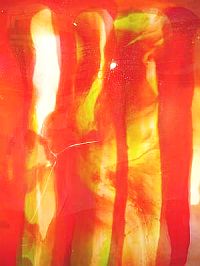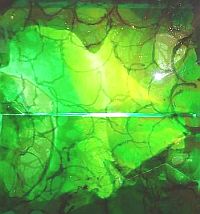The Star, 2 April 2006
Songs for the eye
by J. Anu
SABRI Idrus’s recent Keronchong paintings continue to push the boundaries of new mediums within the art-making process – from both physical and intellectual standpoints.
In a Malaysian artistic climate where painting in its most original form remains the dominant force, both commercially and aesthetically, and where the art institutions (which normally play pioneering roles in supporting new ideas) are currently in some state of transition or other, experimental work remains on the fringe.
Experimenting with alternative, new mediums and how they manipulate the surface has always been central to Sabri’s work. Even as a student, he found the available usual art materials limiting and opted for alternatives like industrial chalk, fiberglass compounds and alternative surface tools – all of which led to the search for tougher, more durable surfaces.
In the process, evidenced in his various bodies of work – from the early metal works through to Lorek Lorek and Bangau O Bangau – Sabri continues to expand the realms of painting.
With the Keronchong Series, the artist has developed a precise and complex way of making his layered picture planes using acrylic pigment and epoxy resin on plastic. The process involves pouring liquid resin into an aluminium tray, and while the resin is still fluid, using plastic pigments to manipulate colour and detail.
In the next stage, he adds a hardening agent of acids and other toxic catalysts in exact measurements, which dictates their rate of hardening. This process is repeated according to the layers of colours and forms he wants.
The process is an exacting science that culminates in back-lit panels of pure aesthetic celebration inspired by the Keronchong and successfully conveys the pure abstract nature of sound.
And then, as if to veer from the intricate mechanics of their making, the artist employs titles appropriated from romantic Keronchong lyrics – Sejenak Terkenang, Sekilas Memandang; DiKala Kalbu; Sejak DiBatas Kota.
In Pertemuan Malam Ini, for instance, the complex colouring and marks have been precisely applied and the surfaces built up in almost wet on wet layers to capture the “image of the sound”. The linear quality and the use of pattern impart a local touch reminiscent of batik. Yet these references are unintentional and spontaneous enough to avoid the quiche.
In Di Kala Kalbu, by situating a prevailing flow of energy within a defined space, Sabri suggests an overflow of their parameters. Though strictly contained within the square of their steel frames, the central forms in these abstract mood studies do not seem curtailed; they are complete. Moreover they imply continuation, as though they have come into view for a fleeting moment, only to disappear around some unseen corner.
Through this immediacy, their rhythmic forms seem revealed only for the time it takes them to be recognised: the paintings in the Keronchong Series all seem to capture particular moments in the life of a song, told in the most pure, energized and absolute abstract terms.
Through the sustained balance of opposites – static and active motifs; fluid forms within a layered rigid surface, as well as precise reinforcing factors like the strong linear quality of the mark-making, the patterned sprays of irregular calculated dollops of brilliant colour and glitter – the artist successfully tunes each painting to an overall sensation. You could almost hear them.
Sabri’s spontaneously considered patterns and forms are biomorphic in feeling. This quality provides a link with Nature which, when considered within the context of their very industrial and scientific method of making, insinuates an immediacy triggered by vague recognition.
These paintings are elemental and instinctive. What is depicted is not so much a feeling or emotion as an evocation of metaphysical energy set within these frames of warm, glowing calm.
The lighting of the panels, the integral element to completing these works by enhancing the gorgeous translucent energy of their layers, raises a few questions concerning their installation.
Metal prong-like constructs are installed to “float” each panel away from the wall. This measured gap gives each work its crucial even wash of light across the picture plane. But the gap between art work and wall reveal the inner workings of tubes and wire, unavoidably detracting from the work.
Sabri has resisted boxing the panels so as to avoid their becoming objects rather than paintings ? he sees them as structural rather than sculptural.
It is daring of him to leave them somewhat naked in favour of the delicacy and grace achieved by the effect of these panels simply hanging in the air, but more thought needs to be given to their installation.
The methodology involved in Sabri’s on-going experimentation with new mediums and the application of formalistic concerns to gradually arrive at the depiction of a heightened moment in experience, seem at odds with each other. That wondrous struggle is evident in his paintings.
Sabri Idrus’ Keronchong Series is a courageous body of work that seeks to find and invent new ways of singing to the eye and he does it with quiet elegance and beneficent beauty.
Keronchong Series is on at the Wei-Ling Gallery, 8 Jalan Scott, Kuala Lumpur, till April 19. Tel: 03-2260 1106.


